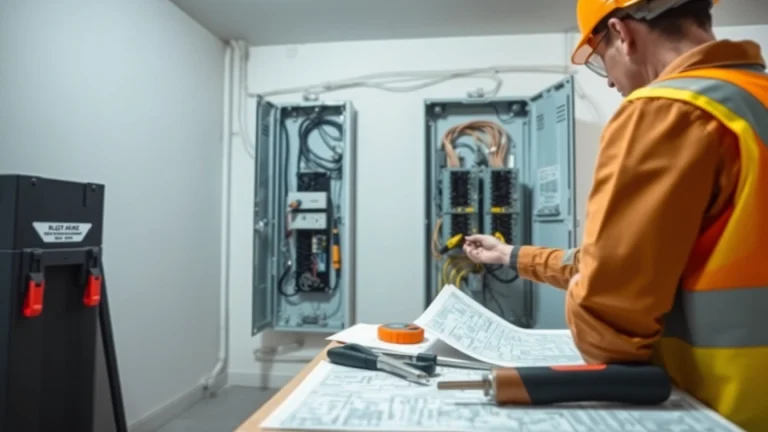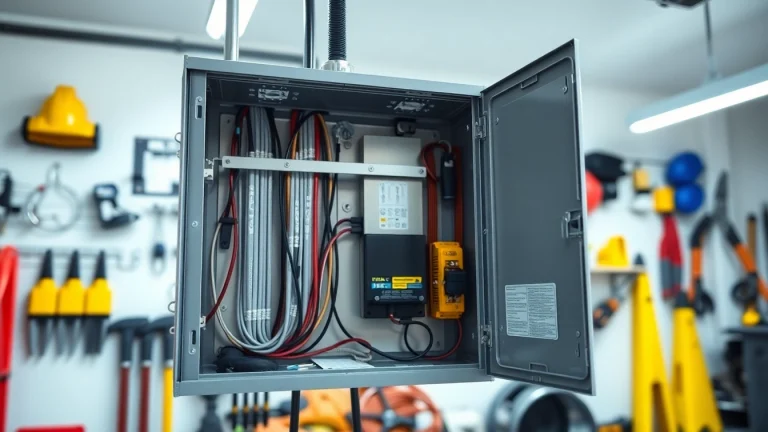
Key Considerations for Your Electrical Panel Upgrade: Benefits and Best Practices
Understanding Electrical Panel Upgrades
What is an Electrical Panel Upgrade?
An electrical panel upgrade refers to the process of replacing or enhancing the main electrical panel that distributes electrical power throughout a home. This upgrade typically involves increasing the amperage capacity, which allows homes to handle greater electrical loads. As our reliance on electronic devices and modern appliances grows, older panels—often rated at 60 or 100 amps—may become inadequate for current demands.
Electrical panels serve a crucial function by controlling the flow of electricity from the main supply to various circuits in your home. To maximize safety and efficiency, upgrading your electrical panel may be essential, especially if you’re planning significant renovations, purchasing new appliances, or wishing to install energy-efficient devices. For more insights on when to upgrade your panel, you might find this Electrical Panel Upgrade guide helpful.
Signs You Need an Electrical Panel Upgrade
Determining whether your electrical panel needs an upgrade involves observing several key indicators. Here are some common signs:
- Frequent Tripping of Circuit Breakers: If your breakers frequently trip, it could indicate that your panel is overloaded or that there is a safety issue with the electrical system.
- Flickering Lights: Flickering or dimming lights, especially when using multiple appliances, point to insufficient power supply or a failing panel.
- Old Electrical Panel: An outdated panel, often over 20 years old, may not meet modern electrical demands or safety standards.
- Burning Smell or Discoloration: Any burning smell or discoloration around the panel is a serious warning of overheating and potential fire hazards.
- Adding New Major Appliances: If you’re planning to incorporate additional large appliances, such as a refrigerator, dryer, or electric vehicle charger, an upgrade might be necessary to handle the additional load.
Benefits of an Electrical Panel Upgrade
Upgrading your electrical panel offers an array of advantages, which not only enhance safety and convenience but also contribute to the overall functionality of your home:
- Increased Electrical Capacity: Upgrading typically expands your limiting amperage (from 60 to 100 amps or even 200 amps), allowing for more devices and appliances to operate simultaneously without risk.
- Enhanced Home Safety: Modern panels come equipped with advanced safety features, such as Ground Fault Circuit Interrupters (GFCIs) and Arc Fault Circuit Interrupters (AFCIs) that protect against electrical shocks and fire hazards.
- Improved Energy Efficiency: Newer panels and circuits are designed to minimize energy loss, which can contribute to lower energy bills over time.
- Increased Property Value: Homes with updated electrical systems often attract higher market values and can yield significant benefits during resale.
Assessing Your Current Electrical System
Evaluating Current Electrical Load
Understanding the current electrical load is essential before considering an upgrade. Start by calculating the total wattage of all electrical devices in your home. This will help you determine if your existing panel can accommodate your needs. An easy way to assess electrical load is to list major appliances along with their wattage:
- Refrigerator: 600 – 800 watts
- Heating/Cooling Systems: 1,500 – 5,000 watts
- Washing Machine: 500 – 1,500 watts
- Lighting: 15-100 watts per bulb (depending on the type)
Sum these values and compare them against your panel’s maximum capacity. If your household’s total demand revises closer or above capacity, you’ll likely need an upgrade.
Identifying Safety Concerns
Safety concerns are paramount when dealing with electrical systems. Inspect your circuit breaker panel for signs of wear, such as rust, moisture, or physical damage. Old wiring and panels pose safety risks, so consider hiring a licensed electrician for a comprehensive inspection. Key safety factors to evaluate include:
- Presence of aluminum wiring, which is more prone to overheating than copper.
- Condition of circuit breakers—general wear and tear can contribute to devices malfunctioning.
- Age of the panel itself; manufactured before 1980 may lack essential safety features.
Understanding Local Regulations and Codes
Before upgrading, familiarize yourself with local electrical codes and regulations, which can dictate the type of panel and installations permissible in your area. These guidelines are in place to ensure safety and continuity in electrical operations. Additionally, obtaining necessary permits is usually mandated, so consult with your local authorities or an electrician to navigate these requirements effectively.
Choosing the Right Electrical Panel
Different Types of Electrical Panels
There are several types of electrical panels available, each suited to different needs:
- Main Breaker Panel: Serves as the primary control point for your electrical system, equipped with a main switch that turns off all circuits.
- Main Lug Panel: Lacks a main breaker and is suitable for sub-panels or when the main disconnect is nearby.
- Subpanels: Installed to manage and distribute power to specific areas of a home, such as a basement or garage, without overloading the main panel.
Understanding the purpose and functionality of each panel type is crucial in deciding what best fits your requirements.
Factors Affecting Panel Capacity
Several factors can influence the capacity of an electrical panel:
- The total amperage. Common choices are 100, 150, or 200 amps; more may be necessary for larger homes or those with high-demand appliances.
- The panel’s circuit configuration. This includes how many circuits you have, their combinations, and overall layout.
- Future planning considerations to account for additional electrical usage, such as electric vehicles or extensive renovations.
Comparing Costs of Electrical Panels
The costs associated with upgrading an electrical panel can vary widely based on several factors, including:
- Size: The cost of the panel increases with its amperage rating.
- Labor: Installation costs differ among professionals based on their experience and the complexity of the upgrade.
- Permitting Fees: Various local authorities may charge for permits that may factor into the overall price.
Typically, a complete electrical panel upgrade might range from $800 to $4,000, depending on these variables.
Preparing for the Upgrade Process
What to Expect During the Upgrade
The process of upgrading your electrical panel generally includes several stages:
- Preparation: The electrician will discuss your requirements, plan the layout, and ensure necessary permits are in place.
- Power Shutdown: A temporary power shutdown will occur to ensure the safe upgrade of your panels.
- Installation: The old panel is removed, and the new one is installed, involving connecting wires and circuits carefully to avoid hazards.
- Testing: After installation, thorough testing will be conducted to ensure every circuit operates correctly and safely.
- Inspection: A local inspector or your electrician will often return to verify compliance with safety codes.
Necessary Permits and Inspections
Acquiring permits is often a legal requirement and part of best safety practices. Permits safeguard you and your home from potential hazards associated with electrical installations. Always check local regulations and follow protocol to ensure a safe upgrade.
Finding Qualified Professionals for Your Electrical Panel Upgrade
Choosing the right electrician is critical for a successful electrical panel upgrade. Here’s how to ensure you find a qualified professional:
- Check Credentials: Ensure the electrician is licensed, insured, and has solid references or reviews from former clients.
- Estimate and Communication: Obtain detailed cost estimates and ensure they are communicative and transparent about the upgrade process.
- Experience: Look for electricians who specialize in panel upgrades and have experience working with the most recent safety codes.
Maintaining Your Electrical System Post-Upgrade
Tips for Regular Maintenance
Following an electrical panel upgrade, maintaining your electrical system is essential for safety and longevity:
- Regular Inspections: Schedule inspections with your electrician to ensure that your system remains in working order and free from wear.
- Clearing the Area: Keep around the electrical panel clear to allow easy access for necessary checks or repairs.
- Monitor Circuit Usage: Keep an eye on your circuit usage. If circuits trip or fuses blow, it may indicate an underlying issue that needs immediate attention.
Monitoring Electrical Usage
Post-upgrade, actively monitoring your electrical usage will empower you to identify inefficiencies or overloading issues. Smart meters and home energy management systems can provide real-time data, allowing for informed decisions about energy consumption.
When to Seek Professional Help After an Upgrade
Even after a successful upgrade, some situations warrant professional evaluation:
- Increased Power Demand: If you considerably altered your electrical use or installed major appliances, reach out to your electrician for advice.
- Signs of Damage or Disruption: Any sign of malfunction, such as flickering lights or unusual noises, should prompt immediate professional assessment.
- Major Renovations: If engaging in major renovations, consult your electrician to ensure your electrical system meets the added demand.


